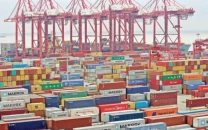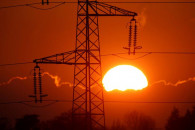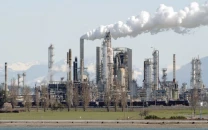Railways performance - learning lessons from the past
Public-private partnership can help achieve greater efficiency and performance

Representational image of railway tracks. PHOTO: REUTERS
It was depressing to note the many financial troubles that this organisation had faced over the past many decades. The colonial period oversaw the largest public-sector investment programme anywhere in the empire, particularly focusing on railways and irrigation. As a result, a vast network of track was laid with a length of 53,596 km in India whereas it stood at 8,122 km in Pakistan. At present, Pakistan has a rail track of 11,881 km, primarily comprising broad-gauge railway. The country has the 22nd largest railway track in the world.
Policymakers over the decades have particularly focused on capital outlays on building and improving road networks over railways. Over the years, this lack of concern and priority has led to poor financial performance and a poorly maintained track network. But it wasn’t always like this. This article argues that there are multiple lessons that can be learnt from the past when the railways flourished.
Railways in Pakistan: a brief history
The first-ever railway constructed in British India was the Red Hill Railway built to transport granite in Madras in 1837. The first passenger train, hauled by three steam locomotives interestingly known as the Sahib, Sindh and Sultan, ran for 34 kilometres between Bori Bunder and Thane in present-day Mumbai.
Railway networks were continuously expanded throughout the colonial rule and the present-day rail network in Pakistan traces its roots from the colonial era when the first-ever railway was constructed and opened for public between Karachi and Kotri in 1861.
The country’s rail system was operated by a network of small private companies including the Scinde Railway, Punjab Railway, Delhi Railway and Indus Flotilla. In 1870, these four companies were merged to form the Scinde, Punjab and Delhi Railway.
Several other railways were also built including the Indus Valley State Railway, Punjab Northern State Railway, Sind-Sagar Railway, Sind-Pishin State Railway, Trans-Balochistan Railway and Kandahar State Railway. These six companies merged with the Scinde, Punjab and Delhi Railway to form the North Western State Railway in 1880.
From 1880 till the time of partition, the North Western State expanded between Punjab and Sindh. An important question that arises is how were the railway systems structured in the past? Can any valuable lessons be learnt?
Public-private partnerships: the case of railways
Various experiments were conducted in history regarding the way railways were managed in the past. In the first phase from 1850-69, private British companies solely constructed and managed the trunk lines under a public guarantee.
In the second phase, the government of India entered the field constructing and managing state railways in the 1870s. The third phase beginning in the early 1880s involved hybrid public-private partnerships with the government of India as the major owner of the lines and private companies in charge of construction and operation.
Finally, in the fourth phase starting 1924, the government of India started taking over railway operations. This model continues to date both in India and Pakistan.
Analysing historical data can teach some important lessons. An eminent academic, Dr Dan Bogart, has worked extensively on Indian railways and has shared some important results regarding the performance of Indian railways during the colonial era. He writes that during the period of public-private partnerships, two of the main measures of railway output - the ton mile and the passenger mile - increased tremendously. The ton mile is a standard measure for freight traffic and the passenger mile is the same for passenger traffic.
Data reveals that during 1884 to 1939, freight output increased by a factor of 9.6 and passenger output by a factor of 6.5. Moreover, during this era, output grew faster than inputs, indicating a general productivity increase for the railways.
Interestingly, the ownership and management structure also influenced capital outlays on railways. Although capital outlays on all railways increased by a factor of 32 between 1860 and 1939, it was during the late 19th and early 20th century when the government became the dominant owner of the lines and cheaper metre gauges were introduced, that there was a general trend towards lower capital outlays.
In general, the paper concludes, from 1850-1919, there was a trend towards higher output, productivity and profits followed by stagnation after 1920. With historical evidence pointing towards greater efficiency and performance of railways on public-private partnerships, can this model be replicated for better performance of our national asset today?
According to an earlier statement by the Pakistan Railways dated September 2017, its decision to outsource commercial management of four trains - Hazara Express, Night Coach, Fareed Express and Shalimar Express - yielded positive results where the revenue increased significantly compared to when they were completely under public ownership.
Can this model be spread over a greater number of trains with the government retaining a few of the lines under its management?Even today, in many countries around the world, public infrastructure is effectively managed under public-private partnerships. A case in point is that of Britain. The country, having one of the oldest railway networks in the world, has a route length of 15,878 km with annual passenger journeys of about 1.7 billion.
Britain nationalised the big four railway companies in 1948 to form British Railways, which was privatised during 1994-97. Ownership of the track was passed on to Railtrack, the predecessor of the modern Network Rail.
Network Rail retains the commercial and operational freedom to manage railway infrastructure in England, within regulatory and control frameworks. Railways have a definite advantage over roads for long haul and mass-scale traffic movement both for passengers and freight in providing a cheap, safe and environment-friendly means of transport. Can this model be replicated in Pakistan for enhanced operational performance? Food for thought for the policymakers.
The writer is a doctoral candidate at The Bartlett, UCL
Published in The Express Tribune, May 6th, 2019.
Like Business on Facebook, follow @TribuneBiz on Twitter to stay informed and join in the conversation.



















COMMENTS
Comments are moderated and generally will be posted if they are on-topic and not abusive.
For more information, please see our Comments FAQ